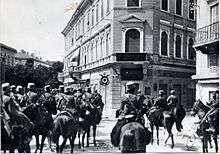Sixth Battle of the Isonzo
| Sixth Battle of the Isonzo | |||||||
|---|---|---|---|---|---|---|---|
| Part of the Italian Front (First World War) | |||||||
 9th August 1916 Italian cavalry enters Gorizia | |||||||
| |||||||
| Belligerents | |||||||
|
|
| ||||||
| Commanders and leaders | |||||||
|
|
| ||||||
| Strength | |||||||
| 22 divisions | 9 divisions | ||||||
| Casualties and losses | |||||||
| 51,000 (21,000 dead) | 41,835 (8,000 dead) | ||||||
The Sixth Battle of the Isonzo also known as the Battle of Gorizia was the most successful Italian offensive along the Soča (Isonzo) River during World War I.
Background
Franz Conrad von Hötzendorf had reduced the Austro-Hungarian forces along the Soča (Isonzo) front to reinforce his Trentino Offensive. Italian Chief-of-Staff Luigi Cadorna made good use of railroads to quickly shift troops from Trentino back to the Isonzo line for an offensive against the weakened Austro-Hungarian defenses.
Battle
On 6 August the offensive was launched against Gorizia. The offensive was concentrated in two zones: the hilly area west of the Soča (Isonzo) river near Gorizia the westernmost edge of the Karst Plateau near Doberdò del Lago. In the Battle of Doberdò, the Italians managed to conquer the main transport road leading from the coast town of Duino to Gorizia, thus securing their advance to Gorizia from the south. The Austro-Hungarian forces had to retreat on the line east of Gorizia (Mount Škabrijel), leaving the heavily damaged town to the Italians.
On 8 August, Gorizia fell to Cadorna and a bridgehead was finally established across the Soča (Isonzo) River. The Austro-Hungarians shifted troops to the Gorizia sector to prevent a breakthrough. Content with having established the bridgehead, Cadorna ended the offensive on 17 August.
The attack on Gorizia was the most successful Italian offensive along the Isonzo lines and greatly boosted Italian morale - especially since Gorizia had been promoted as a desirable objective, unattainable in earlier battles. In the wake of the battle Italy finally declared war against Germany, on 28 August.
The Austrians, who were better equipped, preferred to preserve their forces. The Italian generals, in an attempt to make up for their poor equipment, committed the Italians to frontal assaults, resulting in massive casualties.
If one compares the number of dead Italians and the number of dead Austrians, the one sided-ness of the proportion highlights the high cost to this limited victory. In addition, like all other battles on the Soča (Isonzo), there were many missing soldiers, victims of the superior Austrian artillery.
See also
- First Battle of the Isonzo - 23 June–7 July 1915
- Second Battle of the Isonzo - 18 July–3 August 1915
- Third Battle of the Isonzo - 18 October–3 November 1915
- Fourth Battle of the Isonzo - 10 November–2 December 1915
- Fifth Battle of the Isonzo - 9–17 March 1916
- Seventh Battle of the Isonzo - 14–17 September 1916
- Eighth Battle of the Isonzo - 10–12 October 1916
- Ninth Battle of the Isonzo - 1–4 November 1916
- Tenth Battle of the Isonzo - 12 May–8 June 1917
- Eleventh Battle of the Isonzo - 19 August–12 September 1917
- Twelfth Battle of the Isonzo - 24 October–7 November 1917 also known as the Battle of Caporetto
References
- Tucker, Spencer The Great War:1914-18 (1998)
Further reading
External links
- Sixth Battle of the Isonzo
- FirstWorldWar.Com: The Battles of the Isonzo, 1915-17
- Battlefield Maps: Italian Front
- 11 Battles at the Isonzo
- The Walks of Peace in the Soča Region Foundation. The Foundation preserves, restores and presents the historical and cultural heritage of the First World War in the area of the Isonzo Front for the study, tourist and educational purposes.
- The Kobarid Museum (in English)
- Društvo Soška Fronta (in Slovenian)
- Pro Hereditate - extensive site (in En/It/Sl)